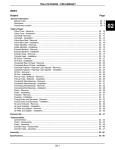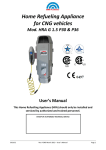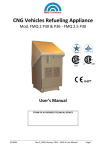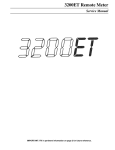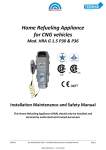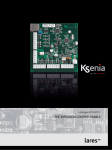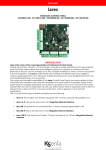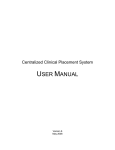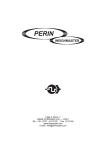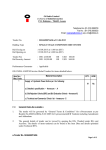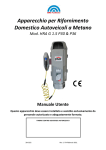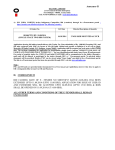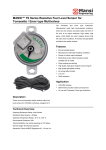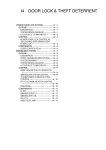Download Use and maintenance booklet of gas equipment
Transcript
Use and maintenance booklet of gas equipment 1. Introduction Dear customer, we would like to congratulate you on choosing our GFI gas conversion system. This booklet wants to get you used to the new system, so please read it carefully before driving your car to avoid any misunderstanding. The use of gas offers many important advantages. First of all, gas refueling cost is considerably lower than the petrol and diesel one. Exhaust emissions of a gas vehicle are cleaner than the petrol and diesel ones. With every journey, you can help thus in reducing the emission of CO2 (responsible for the greenhouse effect) and other harmful substances such as nitrous oxide. Have a pleasant journey with your new GFI system! 2. What are LPG and CNG LPG: LPG is the international acronym for Liquefied Petroleum Gas. It is a crude refining product and a Natural Gas coming from the oilfields. LPG is a complex hydrocarbon mainly made up by propane and n-butane, together with isobutane, propylene, ethane, buthene and pentane in different forms. Used in motor-traction, LPG is a mixture of propane and butane with chemical and physical features giving vehicles excellent performances in terms of power, flexibility and engine good working. It burns without leaving carbon residuals into the engine, preventing so an early engine wear, extending the life of spark plugs, valves and pistons and keeping engine oil features unchanged for longer. LPG diffusion could strongly contribute in reducing pollution caused by fuels burning. Especially, it has low content in carbon, a big advantage in order to reduce carbon oxides emissions. Petrol and diesel vehicles pollute less today, but it is diffusely acknowledged that the main polluting elements, nitrous oxides and particulate dust (microscopic particles including a mix of chemical elements) still are the big problem to face. Even if diesel engines have been strongly improved to reduce carbon oxides, new vehicles equipped with “Common Rail” devices still emits a big quantity of nitrous oxides and particulate dust, compared with new vehicles powered by petrol or converted to LPG. In most of cases, LPG vehicles pollute a 90% less than diesel ones, in terms of nitrous oxides and particulate dust. CNG: is a gaseous mix made up of hydrocarbons mainly composed by methane and, in less quantity, ethane, propane and higher hydrocarbons. Inert gases such as nitrogen and carbon dioxide can be present too. CNG is an excellent fuel for controlled ignition engines; along with suitable engine control and supply 1 technology, it can easily mix with air into the combustion chamber giving many benefits: • excellent distribution of air/fuel mixture; • oexcellent air/fuel ratio control in thermal (cold engine) and dynamic (during acceleration) tip-in and for absence of liquid fuel film into intake ducts; • stoichiometric air/fuel ratio can be maintained during the whole engine working. This means that a good combustion can be obtained, allowing excellent performances, low consumption, very low polluting emissions, almost total absence of carbon residuals into the engine and engine low noise. Thanks to its molecular structure, CNG has a high detonation resistance level (over 120 octane) allowing to use high compression levels, over than 12 / 1, with no need to add chemical additives such as for petrol, increasing so energetic efficiency and reducing consumptions. Thanks to its oxidation resistance high level, CNG is the best fuel for internal combustion engines, because combustion occurs with a flame coherent with spark plugs, allowing high steadiness and low noise level, a very important aspect for our cities. GAS QUALITY The fuel for auto-traction called CNG is a gas mixture that can show some differences according to the geographical zone and to other uncontrollable factors, depending on distribution network manager or supplier. Methane is the main component of Natural Gas, with a quantity between the 84% and the 99,5%. The presence of many gases reduces calorific value of CNG for auto-traction, and, consequently, vehicle performances and autonomy. Also using LPG the autonomy of the vehicle changes a lot because it depends on driving and maintenance conditions, but also on gas composition, which can change from season to season, but from filling to filling too. LPG is in fact a gas composition (Butane and Propane) mixed in a not standard way (sometimes, vehicle can change over to petrol during acceleration for lower tank gas pressure, due to a smaller propane percentage). Only using LPG complying with the European regulation “EN589” assures the right working of gas equipment. Performances (powers, speed, pick-up and consumptions) are slightly lower if compared to the petrol mode, both in LPG and in CNG mode. 3. Guarantee conditions The system good working guarantee, relating to its correct installation, adjustments and maintenance is issued and charged to the installer’s workshop, to whom you can address to for any further information. The producer issues the good working guarantee of every single product bearing the GFI trademark, in accordance with norms and general guarantee conditions in force at the moment of installation. 4. Gas system components Information about equipment dislocation, characteristics and instructions for use is merely indicative. Before picking up your vehicle, please ask your GFI installer for more information. We reserve our right to modify the following chapters without notice. LPG TANK/CNG CYLINDERS It is the biggest and heaviest additional element, and it’s installed in the rear side of the vehicle, strongly fixed to the car body. - lpg: there are two kinds of tanks: cylindrical, housed in a part of the luggage compartment, or ring-shaped, housed in the spare wheel compartment. In both cases, it’s made of heat-treated HT steel and is tested up to 30 bar pressures, that’s to say over the normal working pressure ranging from 2 to 15 bar. Every tank is submitted to the hard tests provided for the Land Transports Department. Moreover, in order to preserve tank and to increase safety, the law orders the 80% filling limitation, limitation automatically managed by the multivalve. - cng: the seamless single-piece cylinders are tested at a pressure more than twice the working one. CNG cylinders amply conform to the stringent international laws about crash-testing and flash point standards. TANK/CYLINDER VALVE - lpg: situated on the tank, multivalve manages many 2 functions, such as: refuelling, filling limitation, level indication, LPG taking with interception solenoid valve, safety valve and excess flow. It is equipped with a manual tap allowing its closing. - cng: every single CNG cylinder is equipped with a special valve performing different functions. First of all, it allows the cylinder closing, separating its contents from the rest of the equipment. Cylinder valve also carries out a breather function, in case of accidental overpressures. As a good rule, it’s better to turn off the tap situated on the cylinders before starting any operation or in case of accident. REFUELLING POINT - lpg: refuelling point, equipped with a non-return valve, is outside the vehicle, in a protected and hidden position, on the rear bumper or near the petrol filler inside the fuel little door. In the former case, to refuelling the car, you have to simply unscrew the cap and connect the gun, while in the latter one it may be necessary to screw the suitable gun adapter. - cng: it is a normal non-return valve having refuelling function, and it’s normally situated in the engine compartment. You can recognize it thanks to a red protection cap or to a black screw cap. As a good rule, it’s better to check the refuelling point cap closing, to avoid possible impurities might compromise its right working. SOLENOID VALVE Housed in the engine compartment, it’s the device that allows the automatic opening and closing of the gas flow from the tank to the engine. It can be provided with a filter for impurities that ought to be periodically replaced. It carries out several safety functions, such as gas flow closing in case of engine accidental switching off, even with key contact switched on. REDUCER It is an important device situated in the engine compartment. Traditional system reducers need periodic overhauling and adjustment not always necessary on reducers of the gaseous injection systems. - lpg: LPG reducers-vaporizers allow reducing pressure to the working values, and provide the heat exchange necessary for the complete LPG evaporation. - cng: CNG reducers allow reducing pressure to the optimal working values. CNG is in gaseous state, so it doesn’t need to be vaporized. GASEOUS PHASE FILTER It has the important task of retaining any gas impurity, preserving in this way the injectors working. In the LPG systems, it’s situated downstream the reducervaporizer, and in the CNG ones, at the reducer inlet. RAIL AND INJECTORS We called “Rail” the element on which gas injectors are housed. It allows the uniform distribution of gas fuel to all injectors. Injector is an electromechanical injector to all intents and purposes, with the task of supplying dosed gas fuel quantity in pressure, and inject it in the intake manifold. A pressure and tempe- rature sensor, situated on the Rail or near it, provides to the ECU all information necessary for managing flow and for automatic petrol-gas and gas-petrol changeover. ECU It is the brain of the whole system and allows performing different kinds of operations, in accordance with the equipment installed: from the simple changeover to some sophisticated carburation controls, from the diagnosis to the emission control, and so on. All ECUs are equipped with “Safety-Car” function that closes solenoid valves in case of engine accidental switching off, even with key contact being on, in order to prevent any possible gas leakage. CHANGEOVER SWITCH Situated in a comfortable position inside the passenger compartment, it allows choosing vehicle powering: gas or petrol. 5. Instructions REFUELING - lpg: refuelling point, equipped with a non-return valve, necessary for LPG refuelling, is generally situated in the vehicle rear side. To refuel, it is necessary to unscrew the plastic protection cap (if existing) and connect the refuelling gun. - cng: refuelling point, equipped with a non-return valve, necessary for CNG refuelling, is generally situated in the vehicle front side (engine compartment). To 3 recharge CNG cylinders, it is necessary to remove the quick coupling protection on which the refuelling gun will be inserted. As soon as the refuelling flow stops, the non-return valve automatically come back in its closing position, obstructing so the body central hole and allowing the gun disconnection without any considerable gas leakage. DIRECTIONS TO FOLLOW DURING THE REFUELLING You are recommended to follow directions and precautions suggested at the filling stations. During the refuelling, it is necessary to follow some simple safety norms: - LPG-CNG: switch the engine off, - LPG-CNG: turn all board lights and radio equipment off, - CNG: get out of your car and go to the suitable station areas. Authorised personnel generally carry out refuelling operation. STARTING UP AND CHANGEOVER Vehicles converted with injection systems in gaseous phase are equipped with a push-button changeover switch with acoustic indicator (Buzzer), on which a gas level indicator is integrated, consisting of 4 green LEDs. Changeover called “One-Touch” is a one-position switch. Fuel change (gas or petrol) is recognised every time the push-button is pressed. ECU recognises and records the fuel state (gas or pe- trol) when you switch off the vehicle in order to repropose the same state at the next switching on. A) Petrol mode: The red round LED turned on informs user of this state; gas level information disappears, that’s to say that the four green level LEDs are turned off. B) Gas Mode: In this state, vehicle starts in petrol mode. Red round LED is on, and gas level LEDs are on in a number depending on the tank gas level. Vehicle changes automatically over to gas mode when program changeover settings are reached. The round LED, by becoming first orange and then green, informs user that changeover has been done. C) Gas-petrol automatic changeover: GFI systems are able to recognize when it’s not possible to supply the engine correctly, because of the end of gas or of the gas supply low pressure. In this situation, with switch in gas position, vehicle automatically changes over from gas to petrol (in this case vehicle can work in petrol mode for short periods). System can automatically come back to gas mode if it recognizes the possibility to supply engine correctly. Otherwise, if system realises it cannot supply engine with gas anymore, it informs user by means of a repetitive buzzing and of the switch red LED turned on. Buzzer can be switched off by putting the switch in petrol position. Now, it’s necessary to refuel to obtain again the vehicle normal gas working. Gas-petrol changeover strategy can be also adopted, in some special conditions and for a few seconds, in order to optimise vehicle working. D) Error indication: In case of possible gas system working anomalies, systems informs user by turning on the two blinking green level LEDs in the middle, and by the round orange LED blinking too. In this situation, changeover switch doesn’t work anymore, and ECU records the fuel mode you had before the error indication. If vehicle was in gas mode, the mode remains the same (idem for petrol mode). If ECU recorded the gas mode, but meanwhile the fuel ends, passage to the petrol mode will be automatic and without any acoustic indication. LEVEL INDICATOR FOR INJECTION AND CARBURETTOR VEHICLES Changeover switch also works as level indicator thanks to its LEDs. Normally, changeover switch has 4 green LEDs showing gas quantity inside the tank (4 LEDs=4/4, 3 LEDs=3/4, 2 LEDs=2/4, 1 LEDs=1/4). Fuel reserve indication is given by the first green LED blinking. NOTE: LEDs indication is purely indicative. It can change from a refueling to another as such as change suddenly because of vehicle movements. We suggest to always use the partial odometer in order to control vehicle autonomy. In some changeover switches, a suitable red LED indicates the fuel reserve. 4 WARNING: Avoid that petrol tank is completely empy. It’s necessary to always keep a petrol quantity corresponding to 1/4 or 1/2 of the tank and periodically refill it. WARNING: Vehicles with On Board Computer: on some vehicles, during the gas mode, information about autonomy and consumptions given by the on board computer and by the petrol level indicator must not to be considered. You can have the real petrol level only when you start the vehicle up. After the changeover to gas, you could perceive a petrol level decrease, proportionally to the kilometres made. After switching the vehicle off, and only after some minutes since the vehicle starting, you can try again to detect the real petrol level. WARNING: A strategy can be activated with some systems, in order to allow short periods of petrol working not indicated by the changeover switch. Please check with your installer if this strategy has been enabled. 6. Useful references LPG TANK OVERHAULING In Italy LPG tank must be replaced 10 years after its final test. Please check the laws in force in your Country about this matter. CNG CYLINDERS TEST In Italy at the moment of the installation, vehicle is equipped with a plastic tag coloured in blue lightgreen showing important data about cylinders installed on the vehicle. Please check the procedure provided for your Country. VEHICLE PERIODICAL OVERHAULING In Italy every car, after its fourth year of life, must be submitted to overhauling. Please check the laws in force in your Country about this matter. ITALIAN DISTRIBUTION NETWORK Dealers’ network amounts today to more than 2000 LPG stations and roughly 600 CNG stations, and it is growing a lot. EUROPEAN DISTRIBUTION NETWORK Dealers’ network amounts today to more than 14.000 LPG stations in 26 Countries and roughly 1.700 CNG stations in 25 Countries. PARKING In Italy CNG vehicles are not submitted to restrictions concerning the underground parking while LPG vehicles can only park in the outside floors and in the first underground floor of garages. Please check the laws in force in your Country about this matter or ask your GFI installer. REFUELLING ADAPTER Before moving to a foreign country, we suggest to check if your refuelling point is the suitable one for the country where you are going to. Please ask your installer for further information. EQUIPMENT DISASSEMBLY Eventual disassembly must be carried out by a GFI authorised workshop. Please check if a new test is necessary in your Country after this operation. CONSUMPTION LPG consumption shows roughly a 20 % increase in comparison with petrol one, but the general feature of this information (percentage comes from the average between high- and low-powered vehicles) makes a specific analysis of any single case necessary. 7. Maintenance schedule A regular maintenance is essential to keep gas system in safety and low costs conditions. Besides the traditional care for a petrol vehicle, your LPG or CNG equipment ought to be submitted to maintenance by the authorised workshop that installed it. Preventive maintenance of gas system components has a vital importance for its good right working. Products’ ageing is a gradual process but, by doing some simple scheduled maintenance checks, you could keep low costs and high safety on your vehicle. First car service The first car service should be carried out by the authorized workshop that installed your LPG or CNG system. It must be made after the first 1.000-1.500 km covered in gas mode. If you had your car serviced 5 by a workshop different from the installer’s one, some costs of labour may be charged. Scheduled maintenance BRC chargeable scheduled maintenance is based on car service coupons to be carried out 10.000, 20.000 km after the installation, and then, every 20.000 km in order to always assure the vehicle and gas system right working. For doing car service, you need to go to your installer and ask for the stamp application on the suitable coupon. These operations will assure the equipment right working and the Guarantee validity. NOTE: Costs of labour for GFI components replacement will be charged to the customer, even if covered by builder’s guarantee, if replacement operations will be carried out by a workshop different from the installer’s one. SCHEDULED MAINTENANCE COUPON after 1.000 km from installation SCHEDULED MAINTENANCE COUPON after 15.000 km from installation SCHEDULED MAINTENANCE COUPON after 30.000 km from installation Plate: ......................................... Vehicle: ................................ Plate: ......................................... Vehicle: ................................ Plate: ......................................... Vehicle: ................................ Date: ...................................... Km: ....................................... Date: ...................................... Km: ....................................... Date: ...................................... Km: ....................................... q Inspection of LPG or CNG system mechanical components q Inspection of LPG or CNG system mechanical componentso q Inspection of LPG or CNG system mechanical componentso q Inspection and replacement of LPG or CNG SV filter (if needed) q Inspection and replacement of LPG or CNG SV filter (if needed) q Inspection and replacement of LPG or CNG SV filter (if needed) q Air filter cleaning q Air filter cleaning q Air filter cleaning q Inspection of spark plugs, cables and ignition system q Inspection of spark plugs, cables and ignition system q Inspection of spark plugs, cables and ignition system q Inspection of connection clamping q Inspection of connection clamping q Inspection of connection clamping q Inspection of water-gas clamps tightening q Inspection of water-gas clamps tightening q Inspection of water-gas clamps tightening q Inspection of carburation with GFI special instrument q Inspection of carburation with GFI special instrument q Inspection of carburation with GFI special instrument q Inspection, cleaning, possible repl. of LPG filter cartridge q Inspection, cleaning, possible repl. of LPG filter cartridge, if needed q Replacement of LPG filter cartridge or filter, if needed q Overhauling of Apache “IG1” injector q Inspection and cleaning of Apache “IG1” injectors q Inspection and adjustment of valves gap q Inspection and adjustment of valves gap Other inspections........................................................................ Other inspections........................................................................ Other inspections........................................................................ GFI workshop’s stamp and signature: GFI workshop’s stamp and signature: GFI workshop’s stamp and signature: 6 SCHEDULED MAINTENANCE COUPON after 45.000 km from installation SCHEDULED MAINTENANCE COUPON after 60.000 km from installation SCHEDULED MAINTENANCE COUPON after 75.000 km from installation Plate: ......................................... Vehicle: ................................ Plate: ......................................... Vehicle: ................................ Plate: ......................................... Vehicle: ................................ Date: ...................................... Km: ....................................... Date: ...................................... Km: ....................................... Date: ...................................... Km: ....................................... q Inspection of LPG or CNG system mechanical components q Inspection of LPG or CNG system mechanical components q Inspection of LPG or CNG system mechanical components q Inspection and replacement of LPG or CNG SV filter (if needed) q Inspection and replacement of LPG or CNG SV filter (if needed) q Inspection and replacement of LPG or CNG SV filter (if needed) q Air filter cleaning q Air filter cleaning q Air filter cleaning q Inspection of spark plugs, cables and ignition system q Inspection of spark plugs, cables and ignition system q Inspection of spark plugs, cables and ignition system q Inspection of connection clamping q Inspection of connection clamping q Inspection of connection clamping q Inspection of water-gas clamps tightening q Inspection of water-gas clamps tightening q Inspection of water-gas clamps tightening q Inspection of carburation with GFI special instrument q Inspection of carburation with GFI special instrument q Inspection of carburation with GFI special instrument q Replacement of LPG filter cartridge or filter, if needed q Replacement of LPG filter cartridge or filter, if needed q Replacement of LPG filter cartridge or filter, if needed q Inspection and cleaning of Apache “IG1” injectors q Overhauling of Apache “IG1” injector q Inspection and cleaning of Apache “IG1” injectors q Inspection and adjustment of valves gap q Inspection and adjustment of valves gap q Inspection and adjustment of valves gap Other inspections........................................................................ Other inspections........................................................................ Other inspections........................................................................ GFI workshop’s stamp and signature: GFI workshop’s stamp and signature: GFI workshop’s stamp and signature: 7 SCHEDULED MAINTENANCE COUPON after 90.000 km from installation SCHEDULED MAINTENANCE COUPON after 105.000 km from installation SCHEDULED MAINTENANCE COUPON after 120.000 km from installation Plate: ......................................... Vehicle: ................................ Plate: ......................................... Vehicle: ................................ Plate: ......................................... Vehicle: ................................ Date: ...................................... Km: ....................................... Date: ...................................... Km: ....................................... Date: ...................................... Km: ....................................... q Inspection of LPG or CNG system mechanical components q Inspection of LPG or CNG system mechanical components q Inspection of LPG or CNG system mechanical components q Inspection and replacement of LPG or CNG SV filter (if needed) q Inspection and replacement of LPG or CNG SV filter (if needed) q Inspection and replacement of LPG or CNG SV filter (if needed) q Air filter cleaning q Air filter cleaning q Air filter cleaning q Inspection of spark plugs, cables and ignition system q Inspection of spark plugs, cables and ignition system q Inspection of spark plugs, cables and ignition system qInspection of connection clamping q Inspection of connection clamping q Inspection of connection clamping q Inspection of water-gas clamps tightening q Inspection of water-gas clamps tightening q Inspection of water-gas clamps tightening q Inspection of carburation with GFI special instrument q Inspection of carburation with GFI special instrument q Inspection of carburation with GFI special instrument q Replacement of LPG filter cartridge or filter, if needed q Replacement of LPG filter cartridge or filter, if needed q Replacement of LPG filter cartridge or filter, if needed q Overhauling of Apache “IG1” injector q Inspection and cleaning of Apache “IG1” injectors q Overhauling of Apache “IG1” injector q Inspection and adjustment of valves gap q Inspection and adjustment of valves gap q Inspection and adjustment of valves gap Other inspections........................................................................ Other inspections........................................................................ Other inspections........................................................................ GFI workshop’s stamp and signature: GFI workshop’s stamp and signature: GFI workshop’s stamp and signature: 8 www.gficontrolsystems.eu GFI Alternative Fuel Systems MTM srl - Società Unipersonale Via La Morra 1, 12062 Cherasco (CN) Italy Phone: +39 0172 486 81 Fax: +39 0172 488 237










